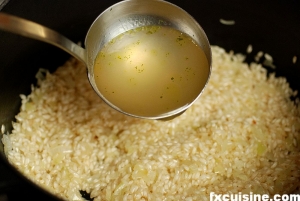A Brief (and Mouthwatering!) History of Risotto
 I was never a Risotto fan. In fact, before we started growing Italian rice here at Blue Moon, I can’t even say that I’d ever had the dish. But then one day, resident rice connoisseur Jim Lyons brought some freshly-cooked risotto into our office. I was hooked. Within a week, I was using our Arborio to make my own Risotto, a ritual I’ve repeated a half-dozen times since.
I was never a Risotto fan. In fact, before we started growing Italian rice here at Blue Moon, I can’t even say that I’d ever had the dish. But then one day, resident rice connoisseur Jim Lyons brought some freshly-cooked risotto into our office. I was hooked. Within a week, I was using our Arborio to make my own Risotto, a ritual I’ve repeated a half-dozen times since.
Risotto’s history is an interesting one. The shorter-grain rice varieties that would later be the dish’s foundation made their way into Sicily and Spain by way of Arab merchants. From there, they spread throughout Italy, consumed mainly by the upper class. But it was not till these varieties caught the attention of elites in Spanish-occupied Milan that the techniques we now associate with modern Risotto—slow-cooking; the use of stock, onions, butter, wine, parmesan, and saffron—were developed. Today, the dish remains largely unchanged.
Almost without exception, Risotto is made from one or more of the following varieties: Arborio, Baldo, Carnaroli, Maratelli, and Vialone Nano. It is because of their ability to absorb liquids and release starch that these are used. Generally speaking, the higher the starch content (amylopectins), the more creamy and textured the final product. That’s why long grain rice—very low in amylopectins, flakier and dryer— makes for a poor Risotto.
As a vegetarian, I’ve never made classic Risotto. Instead of chicken broth, I use vegetable broth, adding spinach and tomatoes, or sometimes even—yes—kale. Their version incorporated our own organic Maratelli rice, and contained, among other delicious ingredients, morel mushrooms. Morels are to Risotto what peanut-butter is to jelly: it’s an amazing combination, one I highly recommend you try ASAP!
 Of course, there are a number of traditional variations on Risotto. There’s Risotto alla Milanese, made with beef stock, bone marrow, lard, and cheese. And Risotto al nero di sepia, prepared with the black ink sacs of cuttlefish. And then there’s Risotto alla zucca, made with pumpkin, nutmeg, and grated cheese.
Of course, there are a number of traditional variations on Risotto. There’s Risotto alla Milanese, made with beef stock, bone marrow, lard, and cheese. And Risotto al nero di sepia, prepared with the black ink sacs of cuttlefish. And then there’s Risotto alla zucca, made with pumpkin, nutmeg, and grated cheese.
But no matter how you prepare your Risotto, one thing is certain: With so many varieties of Italian rice available at Blue Moon, it’s hard to go wrong!
